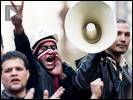
Topics
Guests
- Mona El-Ghobashyassistant professor of political science at Barnard College. She has written on politics and social movements in the Middle East and North Africa.
Just days after the Egyptian labor movement joined the popular uprising that ousted Egyptian President Hosni Mubarak, the ruling military council has called on labor leaders to halt strikes and protests. “Egyptian politics didn’t begin on January 25th,” says Barnard College Professor Mona El-Ghobashy, who has written extensively on politics and social movements in the Middle East and North Africa, “There is a pre-history to this revolt… For us to be able to really understand the significance of what’s happening today, we have to link it to the fabric of Egyptian politics starting in 2000.” [includes rush transcript]
Transcript
AMY GOODMAN: Well, Professor Mona El-Ghobashy just wanted to weigh in here on this news, Reuters reporting that it’s expected that the Supreme Military Council would issue a ban on meetings by labor unions or professional syndicates, effectively forbidding strikes. Professor Ghobashy?
MONA EL-GHOBASHY: If the military actually does that — and this remains an unconfirmed report — this would be a rather dramatic escalation. And the reason being is that Egypt has actually been gripped by a rather extraordinary wave of social protest since at least 2000. This is by no means new. It’s by no means post-February 13th. This is something that’s been happening and peaked in 2006 and 2007, which lends the protest that broke out among civil servants, police officers and other state employees yesterday — it lends it an extra weight. It doesn’t mean that this is now the beginning of a new phase of protest in Egyptian politics. What this shows is a convergence of the old style of protest with a completely changed political environment. That’s the significance of it.
AMY GOODMAN: Well, that’s very important. Just before we go back to Sharif and Issandr, while we talk about the 18 days of revolution that shook the world, this actually goes back before that. And if you can talk about, even amidst the repression, the 30 years of the dictatorship, the level of organizing that was going on, even April 6, named for a previous uprising.
MONA EL-GHOBASHY: That’s right. There’s a pre-history to this revolt. It didn’t — Egyptian politics didn’t begin on January 25th. In fact, what makes the Mubarak regime, and has been cited as a key source of its durability, is its capacity to actually absorb these protests, to manage them quite handily, even when they got so large, as they did, for example, in March 2003, when anywhere between 20,000 to 40,000 people descended on the very same Tahrir Square where Sharif and Issandr are now standing, and camped there for 24 hours to protest the Iraq war and the invasion of Iraq by the United States on March 19th, 2003. And so, for us to be able to really understand the significance of what’s happening today, we have to link it to the fabric of Egyptian politics starting in 2000, for simplicity’s sake, but protests actually occurred in the 1990s, as well. One of the largest protests was a quarry workers’ strike in 1996 that really shook the country at the time. Of course, nobody remembers this now.
But again, the point I want to emphasize is, we are entering in a period, as Issandr mentioned, a real revolutionary moment in Egyptian politics where this constitution and parliament are suspended, but at the same time we have this roiling social structure where almost each and every sector of the population is taking to the streets, grasping the political opportunity afforded by the change of the regime, but they are doing this because they already know how to do that. They know how to encamp on the streets. They know how to negotiate with the government ministers. They know how many people to put on a street corner to make sure that the government minister comes and talks to them on the street corner. That’s why this is significant, not because this is a rebirth of Egyptian politics after February 13th.













Media Options